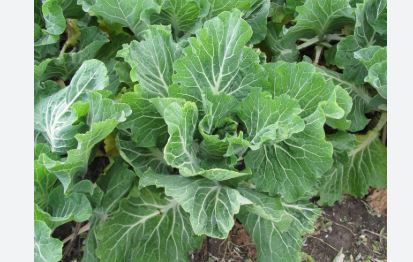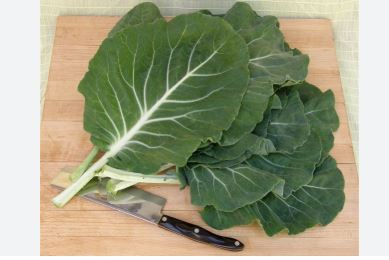
Botanical Classification
Portuguese kale, known as couve galega, is scientifically classified as Brassica oleracea var. acephala or sometimes Brassica oleracea var. viridis, within the Brassicaceae family, which includes cruciferous vegetables like cabbage, broccoli, and collards. The acephala group denotes non-heading brassicas, grown for their loose, edible leaves, while viridis is used for tall, leafy cultivars like couve galega, aligning it closely with collards.
This kale is a landrace, a genetically diverse variety adapted to local conditions, resulting in morphological variability. Its botanical lineage traces back to wild cabbage (Brassica oleracea) from the Mediterranean, domesticated for its foliage rather than heads.
Origin and History
Couve galega originated in the northern provinces of Portugal, particularly the Minho region, with records of its cultivation dating back to the mid-15th century. It became a staple in Portuguese cuisine, especially in the traditional soup caldo verde, reflecting its integration into small-scale farming systems. As a landrace, it adapted to local conditions, resulting in diverse morphotypes.
Portuguese farmers historically selected plants for seed, maintaining high morphological variation. By the 19th century, Portuguese immigrants introduced couve galega to the United States, where it found a niche in home gardens and ethnic markets, particularly in states with Portuguese communities like Massachusetts and California. Its cultivation persists among heirloom growers, though it remains less common than modern kale varieties.
Identifying Characteristics

Couve galega is characterized by its tall, upright growth, often reaching 2-3 meters (6-9 feet) in height, with long petioles and large, midribbed leaves that form an inverted pyramid or dome shape. Leaves vary from smooth to curly, with colors ranging from dark green to blue-green, sometimes with a waxy coating. The plant’s elongated stem and white-flowering habit distinguish it from heading cabbages.
As a biennial or semi-perennial in milder climates (USDA zones 8-10), it produces leaves over multiple years, with some morphotypes, like the “kale of seven years,” forming new lateral leaves for extended periods. Its variability as a landrace means frilly and smooth forms may grow side by side in the same field.
Taste
Couve galega offers a mild, earthy flavor with a slight bitterness and subtle sweetness, less intense than curly kale but more robust than collards. Its tender leaves and succulent ribs have a crisp texture when young, making them suitable for raw preparations, while older leaves soften when cooked, developing a rich, savory taste.
Frost exposure enhances sweetness by converting starches to sugars, improving palatability. In traditional Portuguese dishes, its fine flavor shines when thinly sliced, complementing the creamy base of caldo verde or the bold spices of feijoada, making it a versatile ingredient in American kitchens as well.
Seasons/Availability
Couve galega is a cool-season crop, thriving in temperatures between 7-24°C (45-75°F), with frost tolerance down to -15°C (5°F). In the USA, it’s typically sown in early spring (March-April) or late summer (August-September) for harvests from late spring (May-June) to early winter (November-December).
It grows in USDA zones 2-10, with cultivation concentrated in states like California, Massachusetts, and Rhode Island, where Portuguese communities sustain demand. Peak flavor occurs post-frost in fall, though year-round harvests are possible in mild climates like coastal California. Due to its rarity, couve galega is primarily available through farmers’ markets, specialty grocers, or heirloom seed suppliers, with limited commercial presence.
Culinary Uses
Couve galega is a cornerstone of Portuguese cuisine, most famously used in caldo verde, a traditional soup where its leaves are thinly sliced (1-2 mm) and combined with pureed potatoes, olive oil, and linguiça sausage. In the U.S., Portuguese American communities use it similarly, serving it during winter gatherings or festive occasions.
It’s also featured in feijoada, a pork and bean stew, as a side green. Beyond traditional dishes, its tender leaves are sautéed with garlic, added to soups, or used raw in salads when young. Older leaves are ideal for steaming or braising, offering versatility in American recipes from simple sides to hearty mains, with its vibrant texture enhancing both flavor and presentation
Nutritional Value
Couve galega is a nutrient-dense superfood, low in calories (approximately 49 kcal per 100 g raw) and rich in vitamins, minerals, and phytochemicals. It provides 339% of the daily value (DV) for vitamin K, over 100% for vitamins A and C, and significant amounts of manganese, calcium, and vitamin B6 per 100 g serving.
It contains 3 g protein, 6 g carbohydrates, 3 g fiber, and negligible fat, supporting digestion and overall health. High levels of glucosinolates (e.g., sinigrin, glucoiberin) form compounds with antioxidant and potential anti-cancer properties. Portuguese kales also have elevated protein, calcium, and magnesium compared to other greens, making couve galega a valuable dietary staple.
Cultivation of Portuguese Kale (Couve Galega)
- Climate and Season: Walking Stick Kale grows best in mild, cool climates with temperatures between 7-24°C (45-75°F) and is hardy to -12°C (10°F). In the USA, plant in late summer (July-August) for fall-winter harvests or early spring (February-March) for summer yields. It thrives in USDA zones 6-9, with year-round cultivation possible in mild areas like coastal California.
- Site Selection: Choose a site with full sun (6-8 hours daily) to promote strong stem and leaf growth, though partial shade is tolerated in warmer regions like Southern California to reduce heat stress. Ensure good air circulation to minimize fungal diseases, particularly in humid areas like the Pacific Northwest.
- Soil Requirements: Prefers fertile, well-drained, loamy soil with a pH of 6.0-7.5. Enrich with organic matter like compost or aged manure. In Ecuador, test volcanic soils for acidity and amend with lime if pH is below 6.0 to optimize nutrient uptake for large, tender leaves.
- Soil Preparation: Loosen soil to 12 inches deep, mixing in 2-3 inches of compost or organic matter. Remove rocks and debris to support root and stem development. A soil test confirms proper pH and nutrient levels, essential for maintaining the plant’s long-term productivity.
- Planting: Sow seeds ½ inch deep, spacing 12-18 inches apart in rows 2-3 feet apart to accommodate its tall growth (up to 3 meters). Transplant seedlings started indoors 6-8 weeks earlier for faster establishment.
- Watering: Maintain consistent soil moisture, providing 1-1.5 inches of water weekly, avoiding waterlogging. Use drip irrigation to keep foliage dry, minimizing disease risk in humid climates. Mulch to retain moisture and regulate soil temperature for robust growth.
- Fertilization: Apply a balanced fertilizer (e.g., 10-10-10) at planting, followed by a nitrogen-rich fertilizer (e.g., fish emulsion) every 4-6 weeks to encourage leafy growth. Avoid over-fertilizing to prevent excessive bitterness or weak stems.
- Mulching: Add a 2-3 inch layer of organic mulch, such as straw or bark, to conserve moisture, suppress weeds, and keep roots cool. This is particularly effective in regions with temperature fluctuations, like the Northeast, to stabilize soil conditions for tall plants.
- Pest Management: Monitor for pests like aphids, cabbage worms, and flea beetles, common in brassica crops. Use row covers, neem oil, or introduce beneficial insects like ladybugs. Hand-pick caterpillars for organic control, ensuring healthy, undamaged leaves.
- Disease Control: Prevent fungal diseases like powdery mildew and black rot, possible in humid regions like coastal areas, by ensuring air circulation and avoiding overhead watering. Rotate crops every 2-3 years, a standard practice in states like California, to reduce soil-borne pathogens.
- Harvesting: Harvest outer leaves when 6-12 inches long, about 60-90 days after planting, cutting close to the stem to encourage regrowth. Continue harvesting over multiple seasons in mild climates, as the plant can persist for years before bolting. Young leaves are tenderest for caldo verde.
- Succession Planting: Sow seeds every 2-3 weeks in late summer for continuous leaf harvests in milder climates like California. In cooler regions like New York, focus on single plantings for stem production, as walking stick harvesting requires longer growth cycles.
- Storage and Preservation: Store fresh leaves at 0-4°C (32-40°F) in a perforated plastic bag in the refrigerator for up to 2-3 weeks. For long-term storage, blanch leaves for 2-3 minutes, cool in ice water, dry thoroughly, and freeze to preserve nutrients. Wash and dry before storing to maintain freshness.